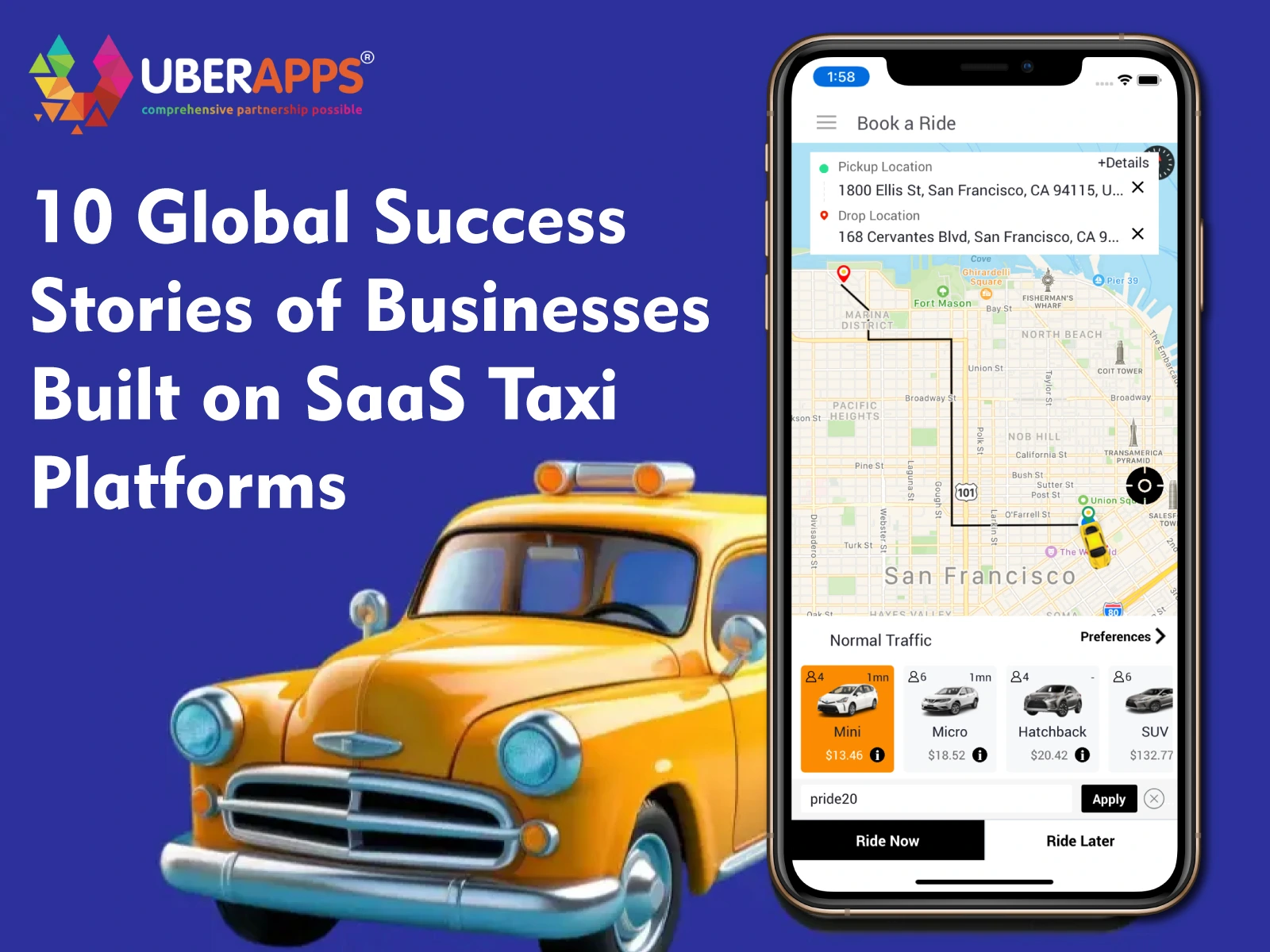
10 Global Success Stories of Businesses Built on SaaS Taxi Platforms
The taxi industry has entered a new era of digital transformation. Entrepreneurs no longer need massive budgets or coding expertise to launch a ride-hailing service. SaaS taxi apps ready to deploy, cloud-based platforms have made it possible for anyone to create a scalable, branded taxi business within weeks.
These platforms combine everything modern mobility companies need:
- Driver and rider apps (Android + iOS)
- Real-time tracking and dispatch
- In-app payments for taxi apps
- Analytics dashboards
- Automated fare management
The biggest benefit? Businesses pay a subscription or one-time licensing fee, avoiding years of development time. Let’s look at 10 global success stories that prove how SaaS-based taxi apps are powering innovation around the world.
The global taxi and ride-hailing industry has evolved rapidly, powered by SaaS-based taxi platforms that make launching new mobility startups faster and more affordable than ever. Instead of spending years and millions developing custom apps, entrepreneurs now use ready-made, scalable SaaS taxi app solutions to go to market in weeks. This blog explores 10 global success stories from regional startups in Africa and Asia to major enterprise scale operators in Europe and the Americas that built their businesses on SaaS taxi software. You’ll learn how these companies leveraged automation, in-app payments, AI-driven dispatch systems, and localization features to dominate local markets. Whether you’re planning to start your own ride-hailing app or simply exploring the future of mobility tech, these stories highlight how SaaS taxi platforms are empowering the next generation of transport innovators worldwide.
1 InDriver Community-Powered Pricing Model
InDriver, born in Russia and now serving over 600 cities globally, built its foundation on a flexible SaaS taxi app model.
Key Highlights
- Unique pricing: Riders propose fares, and drivers accept or negotiate.
- Cloud-based scalability: The platform uses scalable backend systems to handle millions of daily requests.
- AI in taxi app operations: Smart algorithms optimize ride suggestions and reduce waiting times.
Takeaway: InDriver’s growth shows how customizable SaaS platforms can power user-centric innovation—even competing with giants like Uber and Bolt.
2 Bolt – Africa’s Fastest-Growing Ride-Hailing Startup
Bolt (originally Taxify from Estonia) used SaaS-based ride-hailing frameworks to expand quickly into emerging markets like Nigeria, Ghana, and Kenya.
Ride-Hailing App Features
- Localized UI for regional languages and currencies
- Integration of mobile-money payments (MTN MoMo, Airtel Money, etc.)
- Modular dispatch and rating system
Result
Within 3 years, Bolt became Africa’s go-to mobility app, thanks to SaaS scalability and local integrations.
Takeaway: Using a white-label taxi app with regional payment gateways enabled Bolt to localize effectively.
3 Careem – The Middle East’s Super App
Acquired by Uber for $3.1 billion, Careem transformed from a taxi app into a SaaS-driven super-app offering rides, food delivery, and payments.
SaaS Taxi App Advantages
- Built on modular SaaS frameworks allowing quick addition of services.
- Used in-app payments to expand financial inclusion across GCC countries.
- Integrated AI and automation to optimize driver-rider matching.
Takeaway: Careem’s evolution shows how SaaS taxi platforms provide a foundation for multi-service ecosystems.
4 Gojek – From Motorbike Taxis to a Tech Giant
Indonesia’s Gojek started as a call center connecting riders and drivers but scaled using SaaS-based mobility software.
AI in Taxi App Operations
- Real-time demand prediction for surge pricing
- Route optimization powered by machine learning
- Unified wallet for rides, food, and delivery
Takeaway: SaaS flexibility let Gojek expand from motorbike rides to 20+ on-demand services across Southeast Asia.
5 DiDi – China’s Super-Scale SaaS Ecosystem
DiDi Chuxing dominates China’s mobility landscape with advanced SaaS-level integrations across millions of drivers.
Core Innovations
- AI-powered safety systems and telematics
- Predictive fleet management via big data
- Smart route allocation using dispatch algorithms
Takeaway: Even large-scale players rely on SaaS taxi software principles—automation, scalability, and continuous innovation.
6 Oga Taxi – Nigeria’s Homegrown Mobility Success
Africa’s emerging startups have leveraged white-label SaaS taxi apps to fill local market gaps. Oga Taxi in Nigeria is a strong example.
Key Features
- SaaS-based driver management with flexible commission models
- Cashless and card-based in-app payments for taxi apps
- GPS-enabled safety tracking
Takeaway: SaaS taxi platforms empower African entrepreneurs to launch cost-effective, localized ride-hailing services rapidly.
7 Yango – Yandex’s Global Expansion Engine
Russia’s Yango (by Yandex Go) demonstrates how SaaS architecture can support international scaling.
Scalable SaaS Features
- Plug-and-play regional deployments
- AI-driven pricing and dynamic surge control
- Data-driven localization (language, map data, UI themes)
Takeaway: SaaS taxi apps enable consistent quality and quick rollout across multiple countries.
8 Lyft – Leveraging SaaS-Like Microservices
While Lyft built its platform in-house, its architecture follows SaaS microservice design principles—each module (dispatch, payments, analytics) operates independently.
Highlights
- Cloud-native architecture for scalability
- Third-party integrations for analytics and safety
- API-driven fleet management
Takeaway: SaaS-style modularity supports high uptime, flexibility, and future-ready taxi app development.
10 Grab – Southeast Asia’s Everyday App
Grab, operating across Singapore, Malaysia, and Thailand, used SaaS-style taxi platforms to diversify quickly.
Innovative Features
- Built-in ride-hailing + delivery + payments services
- AI-driven customer loyalty programs
- Comprehensive partner dashboards
Takeaway: SaaS frameworks make it easy to evolve from taxi apps to lifestyle ecosystems.
11 Dymond Fleets – Nigeria’s All-in-One Mobility Platform
A modern African case study, Dymond Fleets uses SaaS-based taxi app solutions from Appicial Applications to combine ride-hailing, logistics, and rentals in one app.
Features Powered by SaaS
- Integrated in-app wallet and instant payouts
- Smart driver onboarding with automated verification
- Analytics dashboard for admins
- Multi-city expansion capabilities
Takeaway: Dymond Fleets exemplifies how affordable SaaS taxi apps are driving Africa’s mobility revolution in 2025.
Why SaaS Taxi Platforms Are Winning
1 Lower Development Costs
Traditional app development can cost $100k – $500k, while SaaS taxi platforms reduce costs by up to 80%.
2 Faster Time-to-Market
Pre-built modules mean entrepreneurs can launch within weeks, not months.
3 Continuous Updates
Cloud-based deployment ensures automatic feature and security updates.
4 Built-In Scalability
SaaS systems can handle thousands of concurrent rides without downtime.
5 AI and Automation
AI in taxi apps powers smarter dispatching, fraud detection, and customer analytics.
Key Takeaway: The SaaS model democratizes access to high-tech mobility solutions globally.
Future Trends Shaping SaaS-Based Taxi Apps
1 AI Integration and Predictive Dispatch
Real-time demand forecasting will further optimize fleet efficiency.
2 EV and Sustainability Features
More SaaS taxi apps will add EV support and CO₂ tracking modules.
3 Blockchain Payments
Transparent, instant cross-border payments using decentralized systems.
4 Multi-Service Integration
Expect a surge of “super apps” combining ride-hailing, food, logistics, and financial services.
5 Hyper-Localization
SaaS taxi platforms will let local operators tailor UI, pricing, and language to each city.
Benefits of SaaS Taxi Apps for Entrepreneurs
- Benefit Description
- Low Investment Affordable subscription-based model
- Quick Launch White-label deployment in 2–4 weeks
- Custom Branding Add logos, colors, and regional identity
- Analytics Dashboard Track trips, revenue, and performance
- Integrated Payments Card, wallet, or mobile-money support
Pro Tip: Choosing a SaaS-based taxi app development company like Appicial Applications or Grepix Infotech helps you focus on marketing and scaling while experts handle technology.
How to Build a Taxi Business Using a SaaS Platform
1 Choose Your Target Market
Define your service type rides, logistics, rentals, or super-app.
2 Select a SaaS Provider
Opt for providers offering scalability, multiple app variants, and 24×7 support.
3 Customize and Brand
Use admin panels to modify colors, logos, and app flow.
4 Integrate Payments and Local Features
Ensure support for in-app payments and regional languages.
5 Launch and Promote
Use digital marketing, referral bonuses, and loyalty programs to attract users.
Conclusion
The global success stories of companies like Careem, Bolt, Grab, and Dymond Fleets prove that SaaS taxi platforms have transformed mobility entrepreneurship. No longer limited to billion-dollar corporations, these platforms empower anyone to build a scalable, high-performance taxi or logistics app without deep technical knowledge.
From AI-driven dispatch systems to integrated payment gateways and multi-city scalability, the advantages of SaaS taxi apps are clear: they offer faster launches, lower operational costs, and unmatched flexibility. As 2025 unfolds, the combination of cloud infrastructure, automation, and localization will make SaaS the backbone of the global ride-hailing industry.
If you’re planning to build your own taxi business or expand your existing fleet, consider adopting a white-label SaaS taxi app from a trusted provider like Appicial Applications or Grepix Infotech. With the right technology partner, your brand could be the next success story driving innovation in the on-demand mobility landscape.
FAQS
1. What is a SaaS taxi app?
A SaaS taxi app is a cloud-based, ready-to-launch ride-hailing solution that can be customized and branded for any business.
2. How do SaaS taxi apps save costs?
They eliminate the need for in-house development, hosting, and maintenance—cutting costs by 60–80%.
3. Can I integrate AI in my taxi app?
Yes. Many SaaS taxi platforms include AI for route optimization, driver matching, and predictive analytics.
4. Are SaaS taxi apps suitable for small startups?
Absolutely. SaaS platforms are designed for startups needing quick deployment with low budgets.
5. What features should I look for in a SaaS-based taxi app?
Essential features include real-time tracking, in-app payments, driver management, analytics, and multi-language support.
Author's Bio

Vinay Jain is the Founder of UBERApps and brings over 10 years of entrepreneurial experience. His focus revolves around software & business development and customer satisfaction.

